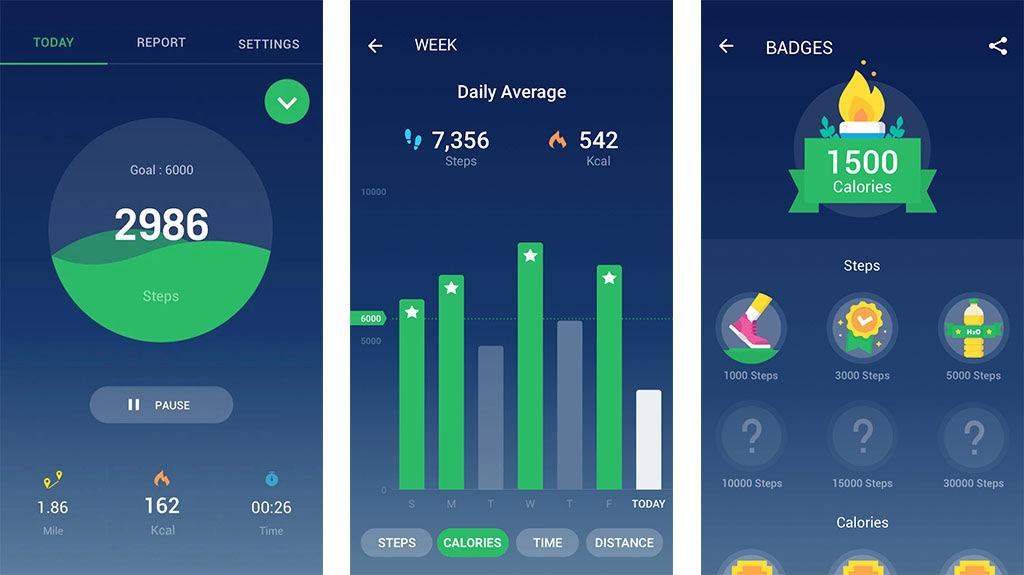Step counter apps are revolutionizing the way we track our fitness progress, providing a wealth of insights and motivation to help us achieve our health goals. From basic step counting to advanced features like GPS tracking and calorie estimation, these apps empower us to take control of our physical activity and make informed decisions about our health.
In this comprehensive guide, we’ll explore the different types of step counter apps available, their key features, and the numerous benefits they offer. We’ll also discuss potential challenges and limitations, as well as integration with other health and fitness apps.
Finally, we’ll delve into market trends and future advancements to provide a glimpse into the exciting evolution of step counter apps.
Overview of Step Counter Apps
Step counter apps are mobile applications that track the number of steps a user takes each day. They use a variety of sensors, such as the accelerometer and GPS, to detect movement and estimate the number of steps taken.
Step counter apps can be used for a variety of purposes, including:
- Tracking progress towards fitness goals
- Motivating users to be more active
- Monitoring activity levels over time
- Identifying patterns in activity levels
There are a variety of different step counter apps available, each with its own features and functionality. Some of the most popular step counter apps include:
- Apple Health
- Google Fit
- Fitbit
- Samsung Health
- Stepz
Step counter apps are becoming increasingly popular, as more and more people are becoming aware of the importance of physical activity. According to a recent study, the global step counter app market is expected to reach $1.5 billion by 2025.
Features of Step Counter Apps
Step counter apps provide various features to enhance the user experience and promote fitness goals. These features range from basic step tracking to advanced health monitoring and motivation tools.
Step Tracking and Goal Setting
Step counter apps primarily focus on tracking the number of steps taken throughout the day. They use sensors in the smartphone or wearable device to detect movement and estimate steps. Some apps allow users to set daily step goals and track their progress towards achieving them.
Distance and Calorie Tracking
In addition to steps, many step counter apps also estimate the distance covered and calories burned based on the user’s height, weight, and step count. This information helps users monitor their overall activity levels and energy expenditure.
Health Monitoring
Some step counter apps integrate with other health tracking apps to provide a comprehensive view of the user’s health. They can track heart rate, sleep patterns, and other health metrics, helping users identify areas for improvement and make informed decisions about their well-being.
Motivation and Rewards
Step counter apps often incorporate gamification elements to motivate users to stay active. They may offer challenges, rewards, or social sharing features to encourage users to reach their goals and maintain a healthy lifestyle.
Innovative and Unique Features
Certain step counter apps stand out with unique features that enhance the user experience. For example, some apps use artificial intelligence (AI) to analyze step patterns and provide personalized insights into the user’s activity levels and health. Others offer guided workouts or fitness plans to help users achieve their fitness goals.
Benefits of Using Step Counter Apps

Step counter apps have emerged as valuable tools for promoting health and fitness, offering numerous benefits to users. These apps leverage technology to track and monitor physical activity, empowering individuals to make informed choices and improve their overall well-being.
One of the primary advantages of using step counter apps is their ability to increase motivation and accountability. By setting daily step goals and tracking progress, users are more likely to stay active and engaged in their fitness journeys. The visual representation of steps taken can serve as a powerful motivator, encouraging individuals to push themselves and strive for improvement.
Enhanced Health and Fitness
Step counter apps contribute significantly to improving overall health and fitness levels. Regular physical activity, as measured by step count, is associated with a reduced risk of chronic diseases such as heart disease, stroke, type 2 diabetes, and certain types of cancer.
By promoting increased movement, these apps help users maintain a healthy weight, improve cardiovascular health, and enhance overall mobility.
Success Stories and Testimonials, Step counter apps
Numerous users have experienced positive outcomes from using step counter apps. Testimonials and success stories highlight the transformative impact these apps can have on individuals’ lives. For example, one user who struggled with inactivity found that using a step counter app helped them gradually increase their daily steps, leading to significant weight loss and improved energy levels.
Another user with mobility issues discovered that the app provided encouragement and support, enabling them to stay active within their limitations.
Challenges and Limitations of Step Counter Apps
![]()
Step counter apps offer a convenient way to track physical activity, but they also come with certain challenges and limitations.
One major challenge is ensuring accuracy. Step counts can be affected by various factors, including the type of device used, the way it is worn, and the user’s gait. For instance, apps that rely on the device’s accelerometer may struggle to differentiate between steps and other movements, such as arm swings.
Additionally, if the device is not worn securely, it may not be able to detect steps accurately.
Factors Affecting Accuracy
- Device type (smartphone, smartwatch, fitness tracker)
- Placement of the device (pocket, waistband, arm)
- User’s gait (walking style)
- Environmental factors (terrain, weather)
Overcoming Challenges
To overcome these challenges, it is important to choose a reliable app that uses advanced algorithms to improve accuracy. Additionally, users should ensure that the device is worn securely and in a consistent location. Calibrating the app regularly can also help improve accuracy.
Integration with Other Health and Fitness Apps

Step counter apps can seamlessly integrate with a wide range of other health and fitness apps, creating a comprehensive ecosystem for users to track and manage their overall well-being.
This integration offers several significant benefits:
- Data sharing:Step counter apps can share data with other apps, such as calorie trackers, sleep monitors, and GPS trackers. This allows users to gain a holistic view of their health and fitness metrics, identifying patterns and correlations.
- Automated tracking:Integration with other apps enables automatic tracking of steps, calories burned, and distance covered. This eliminates the need for manual data entry, reducing errors and improving accuracy.
- Personalized insights:By combining data from multiple apps, step counter apps can provide personalized insights and recommendations tailored to individual users. This helps users set realistic goals, make informed decisions, and stay motivated.
Examples of Successful Integrations
Numerous step counter apps have successfully integrated with other health and fitness platforms. Some notable examples include:
- Google Fit:Integrates with popular step counter apps like Google Pedometer and Fitbit.
- Apple Health:Compatible with step counter apps like StepsApp and Health Mate.
- Samsung Health:Integrates with step counter apps like S Health and AccuPedometer.
These integrations empower users to seamlessly track their steps, monitor their overall health, and achieve their fitness goals.
Market Trends and Future of Step Counter Apps

The market for step counter apps is experiencing significant growth, driven by the increasing adoption of smartphones and the growing awareness of the importance of physical activity. The market is expected to continue to grow in the coming years, as more and more people become interested in tracking their fitness levels.One of the key trends in the step counter app market is the integration of artificial intelligence (AI) and machine learning (ML).
AI and ML can be used to improve the accuracy of step counting, as well as to provide users with personalized insights into their activity levels. For example, some step counter apps use AI to track the user’s stride length and walking speed, and then use this information to provide more accurate step counts.Another trend in the step counter app market is the development of apps that are designed to work with other health and fitness apps.
This allows users to track their steps, as well as other health and fitness metrics, in one place. For example, some step counter apps can be integrated with calorie-tracking apps, so that users can see how many calories they have burned during their walk.The future of step counter apps is bright.
As the market continues to grow, we can expect to see even more innovation in this space. We can also expect to see step counter apps become more integrated with other health and fitness apps, and to provide users with more personalized insights into their activity levels.
Growth Potential
The growth potential for step counter apps is significant. The market is expected to grow at a compound annual growth rate (CAGR) of over 10% in the coming years. This growth is being driven by the increasing adoption of smartphones, the growing awareness of the importance of physical activity, and the development of new and innovative step counter apps.
Future Direction
The future direction of the step counter app industry is likely to be characterized by the continued integration of AI and ML, the development of apps that are designed to work with other health and fitness apps, and the provision of more personalized insights to users.
We can also expect to see step counter apps become more affordable and accessible, as the market becomes more competitive.
Closing Summary

As the fitness landscape continues to evolve, step counter apps will undoubtedly play an increasingly vital role in our pursuit of health and well-being. With their ability to track our progress, motivate us to stay active, and provide valuable insights into our fitness habits, these apps are poised to become indispensable tools for anyone looking to take their fitness journey to the next level.
Top FAQs
How accurate are step counter apps?
The accuracy of step counter apps can vary depending on the device and algorithm used. However, most apps provide a reasonable estimate of steps taken, especially when used in conjunction with a smartphone or fitness tracker.
Can step counter apps help me lose weight?
While step counter apps cannot directly help you lose weight, they can be a valuable tool for increasing your physical activity and burning more calories. By tracking your steps and setting goals, you can stay motivated and gradually increase your daily activity levels.
Are step counter apps suitable for all ages?
Step counter apps are suitable for people of all ages who are looking to track their physical activity. However, it’s important to consult with a healthcare professional before making any significant changes to your fitness routine, especially if you have any underlying health conditions.